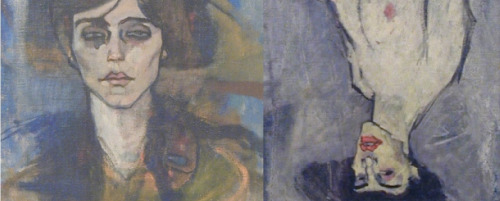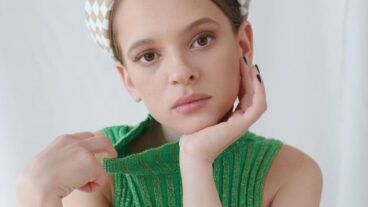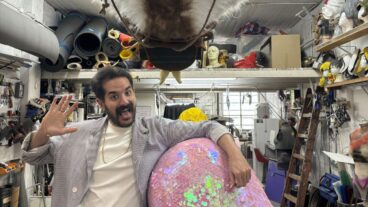An Israeli curator discovers what may be the solution to a riddle about a painting by Modigliani that has mystified the art world for a hundred years.

Not since Van Gogh had there been such a tortured artistic soul. The figurative artist Amadeus Modigliani, most active in Paris at the beginning of the 20th century, lived hard and died young at 35, bequeathing many questions and mysteries to future generations, along with his spellbinding works. Most famous for his paintings, notably of his young lover, some say Modigliani’s style was the culmination of talent, poverty and drug addiction.
While conducting a private tour of the art collection at the Hecht Museum in Haifa recently, curator Ofra Rimon had a revelatory moment when she noticed something she had never observed before in a painting by Modigliani.
It appears that there is a third painting on a canvas that had been thought to depict just two of the master’s works, one of which had puzzlingly been painted upside down. Rimon’s insight seems to point to the discovery that the upside down portrait was actually the third to be executed on the canvas, she tells ISRAEL21c.
Hundred-year-old mystery may be solved
Typical of periods when artists have little money, in the past it was not uncommon to see painters using both sides of a canvas, particularly when they were dissatisfied with their first draft. And that’s what you see in the painting by the Jewish artist that’s part of the collection at the Hecht Museum at the University of Haifa.
The collection was bequeathed to the university by Dr. Reuben Hecht, a founder of its board of governors, who had once met Modigliani’s orphaned daughter in Paris. The rare piece by Modigliani is not representative of his typical style.
Called the Portrait of Maud Abrantes, on the reverse side of the painting and upside down is a portrait of a nude, Nude with a Hat, believed to be the same model in the Modigliani painting The Jewess. Normally, when double-sided paintings are created, whether they portray portraits, landscapes or other subjects, they are painted so that both appear right side up.
To exhibit either one of these two paintings, the curator had to choose which side to hang upside down. It struck her as an oddity, and many in the art world consider it a 100-year-old mystery.
Entering the artist’s mind
Just recently, while giving some guests a private tour of the collection, Rimon noticed what looked like an upside down face superimposed on the Portrait of Maud Abrantes. For her it was a revelatory experience. It appears that not two, but three portraits had been painted on the same canvas. Around the area of Maud’s neck, one can see the faint outline of the face of a woman in a hat.
“Modigliani was probably not happy with that painting and decided to paint over it in favor of a portrait of Maud,” she suggests.
“What bothered me was, what was this drunken man Modigliani thinking by painting a woman upside down? I don’t think it’s rude, it’s just not understood. So one day when I had guests – I always show my guests the Modigliani because it’s the highlight of our collection – I showed it to them. It always bugged me, this question. Suddenly, I saw the answer.
“He’d started with another portrait and wasn’t pleased with it, or thought he could give it up, and painted another portrait on the same canvas. Like a child, he turned the painting, so it wouldn’t disturb him and so there’d be more clean space,” she posits to ISRAEL21c. As far as Rimon knows, no one else has ever suggested this solution to the puzzle before.
“When I was escorting guests in the art wing and drew their attention to this fantastic Modigliani piece, the mystery was solved. In my excitement, I shrieked, ‘Here’s the answer! The mystery is solved!’ “
Painting’s value likely to increase
Painted in 1908, the canvas with the two paintings appearing one on each side, with one painting upside down, is considered irregular in the art world. Perhaps because of this oddity the painting has received attention in a number of important exhibitions in recent years. But art researchers never explored too deeply the question as to why this oddity might have occurred.
Since receiving the painting in 1989, the Hecht Museum has exhibited it so that the two women subjects are alternately shown on their heads, to give both sides their due.
Now that a third woman has come into the picture, it is likely the painting will become more valuable, although Rimon was unwilling to quote the value of the painting or to compare it to Modigliani’s other works. The museum, she adds, also owns three Modigliani drawings.
Inaugurated in 1984, the Reuben and Edith Hecht Museum at the University of Haifa was the initiative of the late Dr. Hecht, who also founded the Dagon Silos Grain Museum in a grain elevator, at the Haifa Port. From a young age Hecht was interested in the archaeology of the Land of Israel, and for 60 years he collected art and archaeological artifacts.
Alongside an extensive archeological collection, which includes a 2,500-year-old boat, an art wing is also part of the permanent collection. The art collection features works that mostly date to the early 19th century, with an emphasis on Impressionism and the work of Jewish artists from the School of Paris. The collection also includes works by Van Gogh, Manet, Monet, Pissarro and Soutine. And of course the mysterious Modigliani painting that gives tourists yet another reason to visit the port city.












